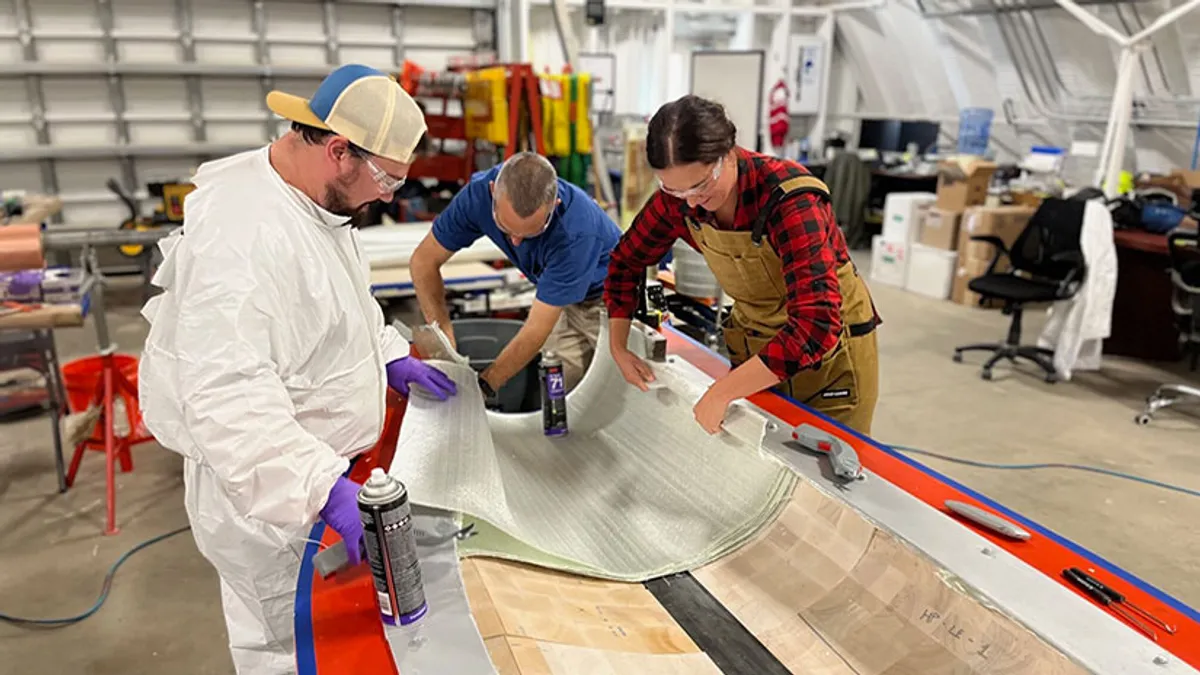Dive Brief:
- Researchers at the National Renewable Energy Laboratory have produced a prototype wind turbine blade held together using an experimental resin made of biobased materials from plant waste, and found it outperformed traditional resins in “creep” testing, the lab announced last week.
- The researchers say that the biobased resin can be depolymerized by manufacturers with relative ease, giving blades that use the resin the potential to be entirely recycled at wind farm decommission sites, cutting down on blade transportation emissions.
- Nicholas Rorrer, a senior researcher in NREL’s biomaterials development and polymer engineering group who worked on the project, said in an email that an “aggressive timeline” could see the resin brought to market in five years, “but without further funding it is hard to say.”
Dive Insight:
NREL said in a release that the resin was created with the goal of meeting or exceeding the structural integrity of existing wind turbine blade resins. The biobased resin, called PECAN, “outperformed traditional resins in the ‘creep’ department” — a measure of “how well the blade holds its stiffness over time.”
“If a wind blade hangs out in the air under its own weight for long enough, you may see it start to lose its stiffness,” said Robynne Murray, an NREL research engineer who worked on PECAN.
Murray said that PECAN’s “unique chemistry” allows it to perform “really well on creep tests.”
Rorrer said that the field of dynamic bonds is “fairly new and evolving,” so the team is not yet certain why the experimental resin outperformed traditional ones.
“We do know that these [bond] networks have a ‘higher crosslink’ density which may lead to creep suppression,” he said. “However, as these networks can be re-arranged, they may be able to go to a lower stress state and be less affected by the deformation.”
NREL said that the team “carefully designed the resin to consist of a network of special chemical bonds (called ester linkages), which can be broken down with safe and affordable chemicals, contributing to the ease of recycling the material.”
Traditional resins are generally made of epoxy resins, which are a class of polymers that include materials like polyurethane and thermoplastic. This requires wind turbines to be made using nonrenewable resources like petroleum, NREL said, and these polymers are “difficult or impossible” to recycle cost-effectively or without degrading the material.
Danish wind turbine maker Vestas announced progress on this front in February, saying that it had engineered a “novel chemical process that can chemically break down epoxy resin into virgin-grade materials.”
NREL’s solution would bypass the need to break down the epoxy by removing it from the equation, but the researchers on the PECAN project are unsure of their timeline for progress.
The next step for the PECAN researchers will be manufacturing a larger blade with the resin, so they can perform “additional structural experiments” before the resin is market ready, NREL said.
Rorrer said he does not have an estimate for when that larger blade will be manufactured, saying the team will need to secure more funding first.














